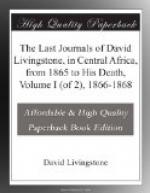at the feet of his countrymen, the writer desires
to give all the honour to his predecessors which
they deserve. The work of Speke and Grant is
deserving of the highest commendation, inasmuch
as they opened up an immense tract of previously
unexplored country, in the firm belief they were
bringing to light the head of the Nile. No one
can appreciate the difficulties of their feat unless
he has gone into new country. In association
with Captain Burton, Speke came much nearer to
the “coy fountains,” than at the Victoria
Nyanza, but they all turned their backs on them.
Mr. Baker showed courage and perseverance worthy
of an Englishman in following out the hints given
by Speke and Grant. But none rises higher in my
estimation than the Dutch lady Miss Tinne, who,
after the severest domestic afflictions, nobly
persevered in the teeth of every difficulty, and
only turned away from the object of her expedition,
after being assured by Speke and Grant that they had
already discovered in Victoria Nyanza the sources
she sought. Had they not given their own mistaken
views, the wise foresight by which she provided
a steamer, would inevitably have led her to pull
up, and by canoes to reach Lake Bangweolo’s sources
full five hundred miles south of the most southerly
part of Victoria Nyanza. She evidently possesses
some of the indomitable pluck of Van Tromp, whose
tomb every Englishman who goes to Holland must see.[67]
Her doctor was made a baron—were she not
a Dutch lady already we think she ought to be made
a duchess.
By way of contrast with what, if I live through it, I shall have to give, I may note some of the most prominent ideas entertained of this world-renowned river. Ptolemy, a geographer who lived in the second century, and was not a king of Egypt, with the most ancient maps made the Nile rise from the “Montes Lunae,” between ten and twelve south lat., by six several streams which flowed north into two Lakes, situated east and west of each other. These streams flowed about west of his river Rhapta, or Raptus, which is probably our Rovuma or Louma. This was very near the truth, but the Mountains of the Moon cannot be identified with the Lokinga, or mountains of Bisa, from which many of the springs do actually arise. Unless, indeed, we are nearer to the great alterations in climate which have taken place, as we are supposed to be nearer the epoch of the mammoth, aurochs, and others. Snow never lay in these latitudes, on altitudes of 6000 feet above the sea.
Some of the ancients supposed the river to have its source in the ocean. This was like the answer we received long ago from the natives on the Liambai or Upper Zambesi when inquiring for its source. “It rises in Leoatle, the white man’s sea, or Metsehula.” The second name means the “grazing water,” from the idea of the tides coming in to graze; as to the freshness of the Liambai waters, they could offer no explanation.




